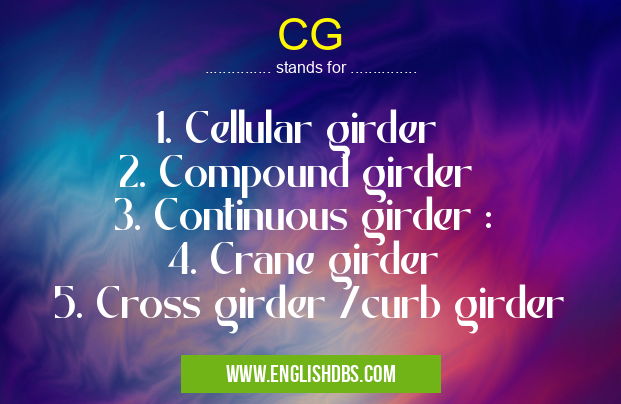What does CG mean in ENGINEERING
CG commonly refers to cellular girder in engineering and construction. Cellular girders are structural elements used in various applications. They are characterized by their unique internal structure, consisting of interconnected cells or voids. This design makes them lightweight, yet highly efficient in carrying loads.

CG meaning in Engineering in Academic & Science
CG mostly used in an acronym Engineering in Category Academic & Science that means 1. Cellular girder 2. Compound girder 3. Continuous girder : 4. Crane girder 5. Cross girder /curb girder
Shorthand: CG,
Full Form: 1. Cellular girder
2. Compound girder
3. Continuous girder :
4. Crane girder
5. Cross girder /curb girder
For more information of "1. Cellular girder 2. Compound girder 3. Continuous girder : 4. Crane girder 5. Cross girder /curb girder", see the section below.
Types of CGs
- Cellular girders
- Compound girders
- Continuous girders
- Crane girders
- Cross girders / curb girders
Applications of CGs
Cellular girders are widely used in:
- Bridges
- Buildings
- Industrial structures
- Offshore platforms
- Shipbuilding
Advantages of CGs
- Lightweight: Their cellular structure reduces their overall weight.
- High strength: They can carry significant loads despite their light weight.
- Structural efficiency: The interconnected cells distribute loads effectively, reducing material usage and minimizing deflections.
- Cost-effectiveness: The optimized design and reduced weight can lower manufacturing and transportation costs.
- Durability: Cellular girders are resistant to corrosion and other environmental factors, ensuring a long service life.
Essential Questions and Answers on 1. Cellular girder 2. Compound girder 3. Continuous girder : 4. Crane girder 5. Cross girder /curb girder in "SCIENCE»ENGINEERING"
What is a Cellular Girder (CG)?
A cellular girder, also known as a castellated beam, is a structural element consisting of a web with regularly spaced openings or cells. These openings reduce the weight of the girder while maintaining its strength and stiffness. Cellular girders are commonly used in bridges, buildings, and other structures.
What is a Compound Girder?
A compound girder is a structural beam that is made up of two or more individual beams connected together. Compound girders are typically used to increase the load-bearing capacity or span of a structure. They are commonly used in bridges, buildings, and industrial applications.
What is a Continuous Girder?
A continuous girder is a structural element that extends over multiple supports. Continuous girders are designed to carry loads that are distributed over their entire length. They are commonly used in bridges, buildings, and other structures where long spans are required.
What is a Crane Girder?
A crane girder is a structural beam that is specifically designed to support a crane. Crane girders are typically made of steel and are designed to withstand the heavy loads and dynamic forces applied by cranes. They are commonly used in industrial buildings, warehouses, and other facilities where cranes are used.
What is a Cross Girder or Curb Girder?
A cross girder, also known as a curb girder, is a structural beam that runs perpendicular to the main girders in a bridge or building. Cross girders provide lateral support to the main girders and help distribute loads across the structure. They are commonly used in bridges, buildings, and other structures where additional support is required.
Final Words: CG is a versatile structural element that combines high strength, lightness, and efficiency. Its applications span various industries, including construction, engineering, and shipbuilding. The cellular design of these girders allows for optimal performance while reducing material usage and costs.
CG also stands for: |
|
| All stands for CG |
